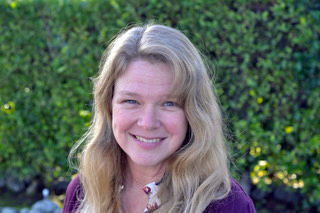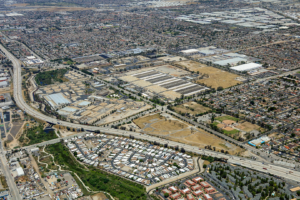Los Angeles is associated with sunny skies, but when storms come, the water they bring can be difficult to manage in the city’s dense urban landscape. Since 2015, the Los Angeles County Sanitation Districts (LACSD) have been legally permitted to aid their member jurisdictions with storm water management. Today, the Districts are figuring out safe and efficient ways to introduce storm water into their sewer systems and treat it to meet water quality standards.
In this interview, Kristen Ruffell, the division engineer for the LACSD’s Water Quality Section, speaks with Municipal Water Leader Managing Editor Joshua Dill about recent advances in storm water management in Los Angeles.
 Joshua Dill: Please tell us about your background and how you ended up in your current position.
Joshua Dill: Please tell us about your background and how you ended up in your current position.
Kristen Ruffell: I have a bachelor of science in civil engineering from Cal Poly, San Luis Obispo, and a master’s in environmental engineering from the University of Illinois at Urbana-Champaign. I have worked at the Los Angeles County Sanitation Districts since 1999. I spent the beginning of my career with the Districts in the Sewerage Collection System and Treatment Plant Monitoring Sections, and have supervised and then managed our Water Quality Section since 2007.
Joshua Dill: Would you give us an overview of the Sanitation Districts as a whole? What services do they provide, and how does storm water management fit in?
Kristen Ruffell: The Sanitation Districts consist of 24 independent special districts serving about 5.6 million people in Los Angeles County. Our service area covers approximately 850 square miles and encompasses 78 cities and unincorporated areas in the county. The Sanitation Districts were created in 1923 to construct, operate, and maintain facilities that collect, treat, and dispose of domestic and industrial wastewater. At that time, a significant number of cities were forming, and it was clear that managing wastewater on a regional scale made sense. The Districts operate and maintain the larger, regional collection systems, while cities and unincorporated areas within each district are responsible for their smaller collection systems. Cities and unincorporated parts of the county are also responsible for the collection of solid waste. In the 1950s, it became apparent that solid-waste management would benefit from a regional approach. At that time, the Sanitation Districts were given the responsibility of providing for solid-waste management, which today includes the disposal and transfer of collected solid waste and recovery of recyclable materials and energy. Recently, California law was amended to give our agency the authority to assist our cities with storm water management.
Joshua Dill: I tend to think of Los Angeles as an arid place without a lot of storms or storm water. How much storm water is there, and how does it affect the city?
Kristen Ruffell: It doesn’t rain very often in Los Angeles County, but when it does, the storms can be fed by so-called atmospheric rivers that deliver up to 15 times the flow at the mouth of the Mississippi River in the form of rainfall over California. These intense storms typically last for several days, and it’s been documented that 30–50 percent of the annual precipitation in the region comes from just a few atmospheric river events.
Joshua Dill: How is storm water being managed today?
Kristen Ruffell: The Los Angeles County Flood Control District (a separate agency from my own) has done a terrific job of protecting lives and property by building a system of storm drains and flood control channels to drain storm water off the landscape as quickly as possible, conveying some of the water to conservation facilities and ensuring that the rest can be conveyed to the ocean without causing major flooding. With recent changes in permitting requirements, however, the municipalities in Los Angeles County have had to ensure that the water meets certain quality standards before it goes into local rivers and creeks. It is a significant challenge to add treatment to an existing network of pipes and channels, without increasing flood risk, in an area that is already built out with homes and businesses.
That’s where the Sanitation Districts can help. The Sanitation Districts operate a separate network of pipes that convey sewage for treatment at our water reclamation plants. In some areas, or at certain times of day, there is capacity in our system that can be used to convey some of the storm water to the existing treatment facilities after the storm-related peaks in our system have subsided. The recent change in the law allows us to help the cities develop projects to comply with their permits.
Let me zero in on a project that the LACSD is doing for the City of Carson. The city’s enhanced watershed management plan had it building an infiltration project at Carriage Crest Park, which happens to be right across the street from our Joint Water Pollution Control Plant. The city asked us to help it develop the project and oversee its design and implementation.

Initial investigations found that infiltration was not possible at the park due to groundwater contamination from a former gas station near the park. The Sanitation Districts helped convert the project to a sewer diversion project that could cost-effectively handle significantly more storm water than the original project (27 acre-feet versus the originally planned 9 acre-feet).
The City of Carson had funding from a cooperative implementation agreement through the California Department of Transportation; the County of Los Angeles decided to join the project and contribute funding in exchange for the expansion of the project to manage the design storm from its area as well. The design storm is a 24-hour, 85th-percentile storm, which deposits about an inch of rain.
The project is currently in construction and will divert storm water to a new cistern beneath the park and then send the water to the sewer when capacity is available. There will be a control system that measures the level in the sewer in real time. When the sewer has available capacity, discharge pumps divert water out of the storage and into the sewer; when the sewer is running full, as it will during some storms, the system turns off the sewer diversion pumps and the storage continues to fill. When the storage is full, the system closes the influent valve to allow flows from large storms to bypass the system. The real-time diversion system will make the 13½ acre-feet of storage in the park operate like 27 acre-feet of storage and will allow the City of Carson and the County of Los Angeles to capture the compliance storm for all their land area within the subwatershed.
Joshua Dill: Is the captured water immediately treated?
Kristen Ruffell: The storm water receives secondary treatment at the Joint Water Pollution Control Plant, which, as I mentioned, is right across the street from the project. It is treated along with the wastewater flows in that plant. After treatment, the effluent is discharged into the ocean.
Joshua Dill: Is all the water from the Joint Water Pollution Control Plant discharged into the ocean?
Kristen Ruffell: A small amount of treated effluent is used within the plant, but almost all the flow is currently discharged to the ocean. Metropolitan Water District is in the process of constructing a demonstration plant to test a purification process that may eventually allow the effluent to be reused for groundwater replenishment. The MWD Advanced Purification Center demo plant will start operation in March 2019. The demo plant will allow Metropolitan to test the process and obtain regulatory approval for a potential full-scale reuse project. At the Sanitation Districts’ other wastewater treatment facilities, almost all of the effluent is reused for industrial, commercial, and recreational applications; groundwater replenishment; agriculture; and the irrigation of parks, schools, golf courses, roadways, and nurseries.
Joshua Dill: What are the challenges of storm water management in Los Angeles as compared to other cities?
Kristen Ruffell: One of the most significant challenges of storm water management in Los Angeles County is that the county is already built out. The available places to capture storm water and treat it are few and far between. Also, in a number of places, the storm drain systems are open channels, rivers, and streams that are subject to the requirements of the Clean Water Act. It has been a challenge for the cities in Los Angeles County to capture storm water and treat it before it makes it to the open-channel portion of the storm drain system, where water quality standards apply.
Joshua Dill: What other major challenges are part of your everyday work?
Kristen Ruffell: The other major challenge for our municipalities is that, despite being required by the Clean Water Act, storm water treatment hasn’t had a funding source. Some of that has been improved by Los Angeles County’s Measure W, which was passed by the voters on November 6. Measure W provides a small parcel tax that municipalities can use to fund the projects necessary to comply with their permits. In many cases, the captured and cleaned storm water can then be used to increase local water supplies.
Joshua Dill: What are the recent advances that have aided you in your storm water management work, and what is your vision for the future?
Kristen Ruffell: Until very recently, the Sanitation District’s had discouraged the introduction of storm water into our sewage system. We permitted a handful of dry-weather diversions along the beaches to protect the water quality and swimmer safety. Those existing diversions have been required to wait 24 hours after rainfall before pumping into the sewer to reduce the risk of overflow. Diversions had not been allowed in inland areas. Since then, the Sanitation Districts have been evolving and looking for places where we can accept storm water for treatment through our system in a safe way. We’ve developed Carriage Crest Park immediately upstream of a treatment plant, and we are looking into what it would take to introduce stored storm water into our system further upstream.
Eventually, I believe that the sewer system will need to be instrumented to allow for full use of its capacity. Installing level sensors at key locations and using the data to control diversions creates an opportunity to optimize and coordinate the growing network of storm water storage facilities in the county with the dual goal of achieving compliance with the storm water permit and creating additional water supplies from storm water that is currently lost to the ocean.
Kristen Ruffell is the manager of the Los Angeles County Sanitation Districts’ Water Quality Section. She can be reached at kruffell@lacsd.org.
